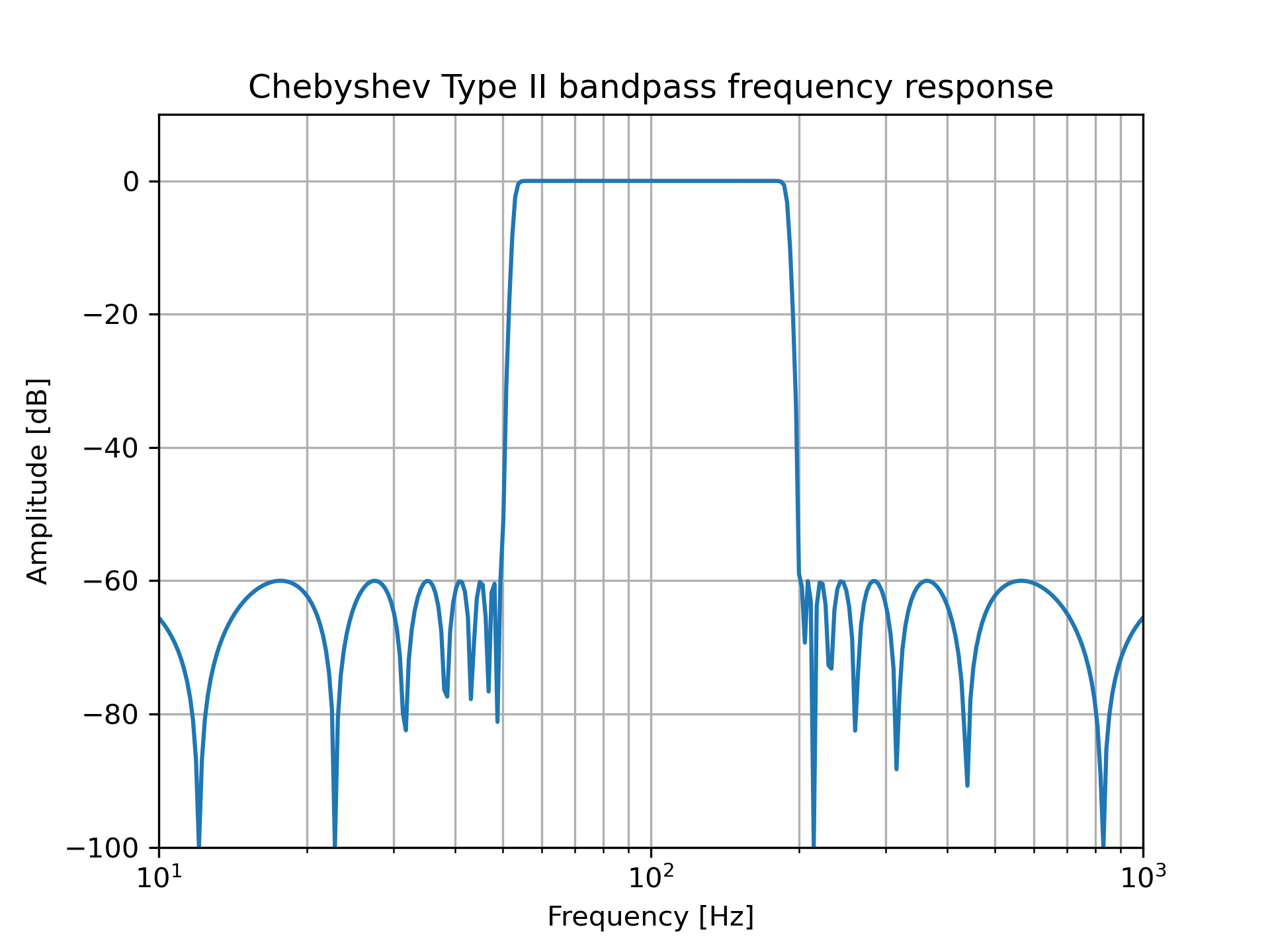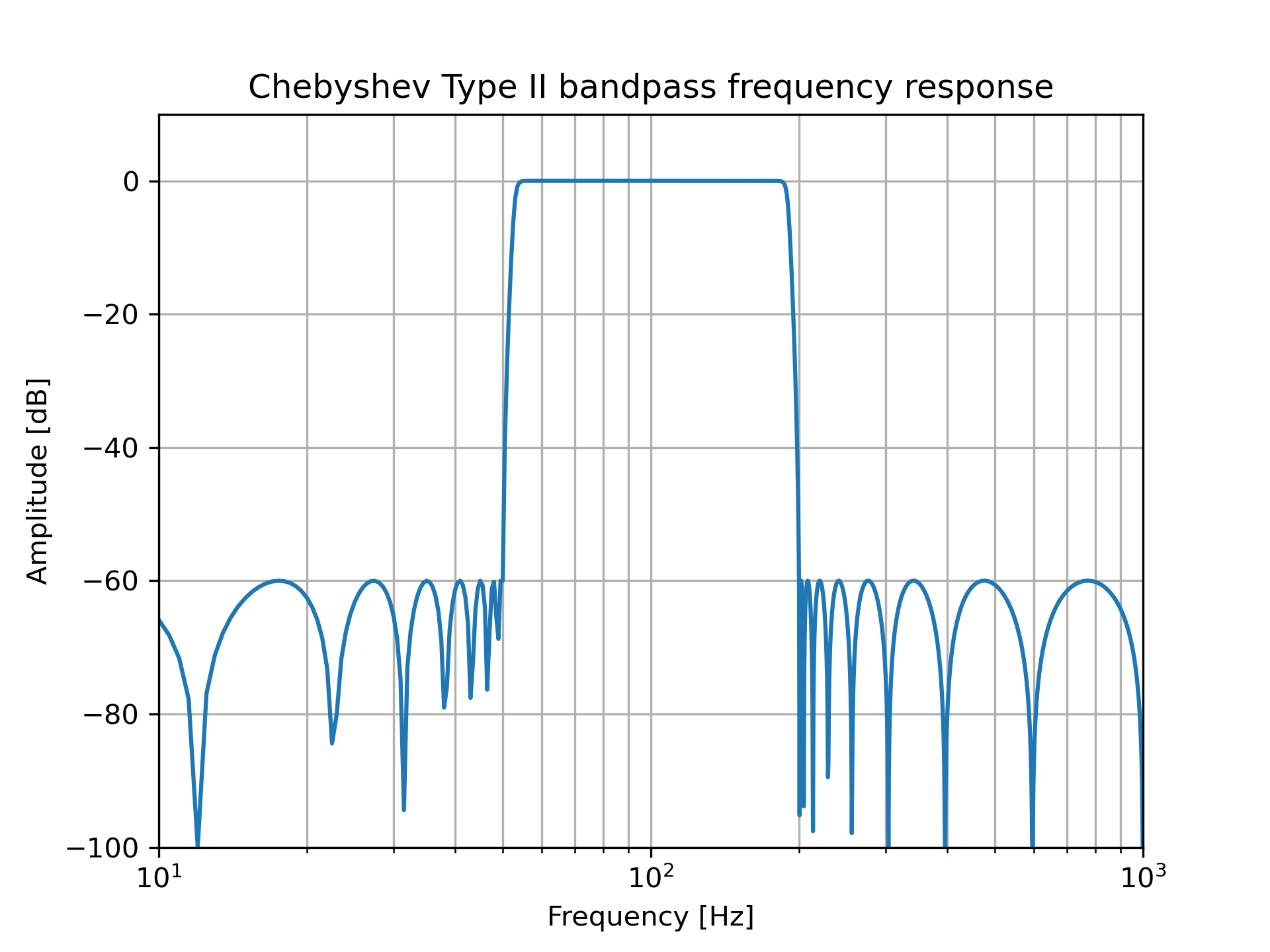iirfilter(N, Wn, rp=None, rs=None, btype='band', analog=False, ftype='butter', output='ba', fs=None)
Design an Nth-order digital or analog filter and return the filter coefficients.
The 'sos'
output parameter was added in 0.16.0.
The order of the filter.
A scalar or length-2 sequence giving the critical frequencies.
For digital filters, :None:None:`Wn` are in the same units as :None:None:`fs`. By default, :None:None:`fs` is 2 half-cycles/sample, so these are normalized from 0 to 1, where 1 is the Nyquist frequency. (:None:None:`Wn` is thus in half-cycles / sample.)
For analog filters, :None:None:`Wn` is an angular frequency (e.g., rad/s).
For Chebyshev and elliptic filters, provides the maximum ripple in the passband. (dB)
For Chebyshev and elliptic filters, provides the minimum attenuation in the stop band. (dB)
The type of filter. Default is 'bandpass'.
When True, return an analog filter, otherwise a digital filter is returned.
The type of IIR filter to design:
Filter form of the output:
The sampling frequency of the digital system.
Numerator (b) and denominator (a) polynomials of the IIR filter. Only returned if output='ba'
.
Zeros, poles, and system gain of the IIR filter transfer function. Only returned if output='zpk'
.
Second-order sections representation of the IIR filter. Only returned if output=='sos'
.
IIR digital and analog filter design given order and critical points.
butter
Filter design using order and critical points
buttord
Find order and critical points from passband and stopband spec
iirdesign
General filter design using passband and stopband spec
Generate a 17th-order Chebyshev II analog bandpass filter from 50 Hz to 200 Hz and plot the frequency response:
>>> from scipy import signal
... import matplotlib.pyplot as plt
>>> b, a = signal.iirfilter(17, [2*np.pi*50, 2*np.pi*200], rs=60,
... btype='band', analog=True, ftype='cheby2')
... w, h = signal.freqs(b, a, 1000)
... fig = plt.figure()
... ax = fig.add_subplot(1, 1, 1)
... ax.semilogx(w / (2*np.pi), 20 * np.log10(np.maximum(abs(h), 1e-5)))
... ax.set_title('Chebyshev Type II bandpass frequency response')
... ax.set_xlabel('Frequency [Hz]')
... ax.set_ylabel('Amplitude [dB]')
... ax.axis((10, 1000, -100, 10))
... ax.grid(which='both', axis='both')
... plt.show()

Create a digital filter with the same properties, in a system with sampling rate of 2000 Hz, and plot the frequency response. (Second-order sections implementation is required to ensure stability of a filter of this order):
>>> sos = signal.iirfilter(17, [50, 200], rs=60, btype='band',
... analog=False, ftype='cheby2', fs=2000,
... output='sos')
... w, h = signal.sosfreqz(sos, 2000, fs=2000)
... fig = plt.figure()
... ax = fig.add_subplot(1, 1, 1)
... ax.semilogx(w, 20 * np.log10(np.maximum(abs(h), 1e-5)))
... ax.set_title('Chebyshev Type II bandpass frequency response')
... ax.set_xlabel('Frequency [Hz]')
... ax.set_ylabel('Amplitude [dB]')
... ax.axis((10, 1000, -100, 10))
... ax.grid(which='both', axis='both')
... plt.show()

The following pages refer to to this document either explicitly or contain code examples using this.
scipy.signal._filter_design.freqs
scipy.signal._filter_design.ellipord
scipy.signal._filter_design.iirfilter
scipy.signal._filter_design.cheb1ord
scipy.signal._filter_design.buttord
scipy.signal._filter_design.gammatone
scipy.signal._filter_design.freqs_zpk
scipy.signal._filter_design.cheb2ord
scipy.signal._filter_design.iirdesign
Hover to see nodes names; edges to Self not shown, Caped at 50 nodes.
Using a canvas is more power efficient and can get hundred of nodes ; but does not allow hyperlinks; , arrows or text (beyond on hover)
SVG is more flexible but power hungry; and does not scale well to 50 + nodes.
All aboves nodes referred to, (or are referred from) current nodes; Edges from Self to other have been omitted (or all nodes would be connected to the central node "self" which is not useful). Nodes are colored by the library they belong to, and scaled with the number of references pointing them